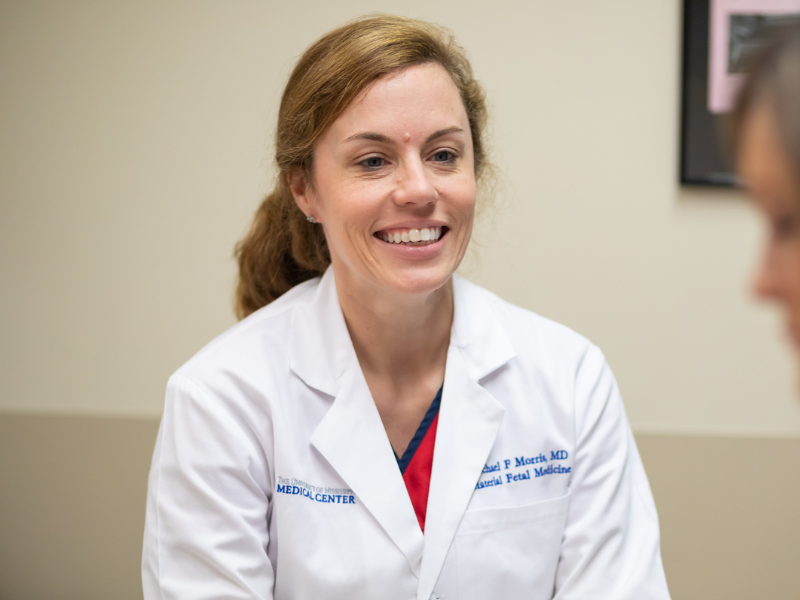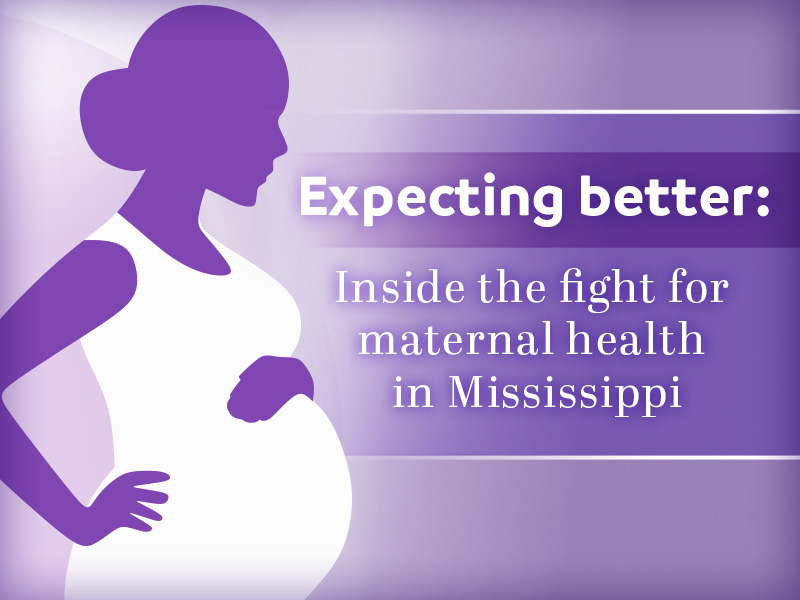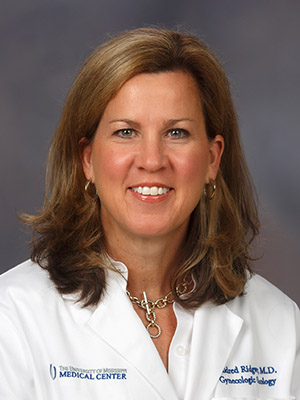Early detection, multidisciplinary care saves patients with life-threatening condition

Editor’s Note: Over the next three weeks, we will take a closer look at the University of Mississippi Medical Center’s work through its three-part mission of education, research and health care to address the state’s maternal health crisis. These stories, which will be part of an occasional series examining the state’s only academic medical center’s role in fighting some of the most pressing health issues, share the experiences of caregivers, researchers, patients and learners. We hear from those affected by maternal health challenges and from those who are fighting against them in the hospital room, lab and classroom.
 Sherika Farmer was expecting her fifth child when an ultrasound revealed a life-threatening condition: placenta accreta.
Sherika Farmer was expecting her fifth child when an ultrasound revealed a life-threatening condition: placenta accreta.
“I was so shocked by the diagnosis,” she said. “Our whole family was praying. It was very scary.”
Thanks to diagnosis by her obstetrician and a referral to the University of Mississippi Medical Center, she received care from a team of experts throughout her pregnancy and the birth of daughter, Dreahm Straughter, in March.
Led by Dr. Rachael Morris, associate professor of obstetrics and gynecology and program director of maternal fetal medicine, and Dr. Mildred Ridgway, professor of obstetrics and gynecology and associate chief medical officer for adult care at UMMC, the placenta accreta team includes multiple medical specialties throughout the Medical Center.
“Dr. Morris made sure I knew the risks, and they took very good care of me,” Farmer said. “The entire team came in for Dreahm’s birth. It was scary, but I knew I was in good hands.”
Access to prenatal care is essential for early PAS diagnosis and treatment. A prenatal ultrasound can spot the condition during pregnancy.

For many expectant mothers in Mississippi, prenatal care can be out of reach. The March of Dimes defines 51.2% of Mississippi counties as "maternity care deserts,” compared to 32.6% of U.S. counties., and 24.3% of Mississippi women have no birthing hospital within 30 minutes of their homes. The U.S. figure for that shortage is 9.7%.
“If diagnosed at the time of delivery, there is a life-threatening complication with an unprepared team and hospital,” Morris said. “Prenatal diagnosis is the key to saving the life of the mother.
“At that point, a team of specialists will be needed to save the life of the mother,” Morris said. “It is best-case scenario for the patient and fetus to have a referral to UMMC’s Center for Maternal and Fetal Care in the early second trimester for high-resolution ultrasound and diagnosis. It allows us to manage anemia and optimize maternal medical conditions prior to surgery. It also allows time for counseling, coordination and planning of these complex surgeries.”
When the placenta grows into the walls of the uterus, a rare and complex condition known as placenta accreta, or placenta accreta spectrum (PAS), can occur, creating life-threatening complications for mothers and babies. Many times, hysterectomy and large volume blood transfusions are needed to save the mother’s life.
PAS can range from placenta accreta to placenta increta, when the placenta extends into the uterine wall, and placenta percreta, which happens when the placenta passes through the uterine wall. Placenta increta and placenta percreta are less common, happening in 15% and 5% of cases, respectively.
Having those specialties available at UMMC allows for multidisciplinary collaboration and innovation in diagnosing and treating placenta accreta.

“This is only possible at an academic medical Center like UMMC, given the breadth and variety of highly trained specialists and subspecialists all at one center,” Ridgway said. “The team incorporates subspecialty trained anesthesiologists, fellowship-trained trauma surgeons, maternal-fetal medicine specialists, gynecologists, obstetricians, urologists and other staff members including gynecologic oncologists, who have expertise in hysterectomies.
Morris agreed, noting the Medical Center’s technology and complex care capabilities.
“Patients treated by our team have access to advanced imaging technologies such as high-resolution ultrasound and MRI and expertise in interpreting complex diagnostic results, which are critical for accurately diagnosing and assessing the extent of placenta accreta,” Morris said. “Placenta accreta can result in significant hemorrhaging during delivery, requiring immediate and intensive care. Academic hospitals typically have more resources, such as blood banks, operating rooms equipped for complex surgeries, and specialized post-operative care units, to handle such emergencies.”
Farmer’s obstetrician in Cleveland referred her to Morris and UMMC “to see if they were seeing what he saw,” she said.
At UMMC, a caesarian hysterectomy was planned. During her pregnancy, Farmer traveled to Jackson for ultrasounds and examinations, and Dreahm’s delivery was planned for “35 weeks and four days,” she said.
Because of the placenta accreta, a hysterectomy was performed, and her left ovary and tube were removed. She stayed overnight in intensive care at UMMC but recovered well.
“I was able to see my baby the next day,” Farmer said.
The team, in place since 2018, has seen an increase in placenta accreta, which has been on the rise over the last several decades.
"Recent studies estimate the occurrence of PAS in approximately one in 272 to one in 500 births,” Morris said. “As the only academic medical center in the state and the tertiary care center for referrals, our rates of PAS disorders are high and have seen a significant increase in the last several years.”
Over the decades, the number of PAS cases have grown from 1 in 30,000 pregnancies in the 1960s to 1 in 272 pregnancies by 2016. Risk factors for PAS include being over 35, previous childbirth, earlier caesarian sections and having Asherman syndrome, a condition where scar tissue forms in the uterus, mainly from uterine surgeries. Having placenta previa, a condition where the placenta partially or completely blocks the cervix, also puts women at risk, as it is seen in 80% of PAS cases.
Ridgway said the Medical Center sees about 15 to 20 mothers with placenta accreta each year, a figure that has grown since the team’s start.
Most placenta accreta cases are referred to UMMC later, in or approaching the third trimester.
“We have managed many same-day, next-day and overnight transfers from across the state with emergency mobilization of the team and expertise with very short notice,” Morris said. “Average blood loss for an extensive case can be 2.5-5 liters, which is the body’s entire blood volume. We work closely with our blood bank to secure matched blood and blood products for each patient, including getting units from across the country.”
UMMC’s resources are needed to save the lives of mothers with placenta accreta.
“Smaller hospitals face huge challenges with blood availability for these cases,” she said. “Despite the challenges we face with increasing maternal obesity and high-risk maternal pre-existing conditions, our team continues to refine our process, improve outcomes and save lives on a daily basis. Our average blood loss and ICU stays are well below the national average.”
An early diagnosis such as Farmer’s increases the odds for the best outcomes for mothers and babies.
“An early diagnosis of placenta accreta is essential because it can allow multiple health care providers to become involved in your pregnancy and delivery care,” Morris said. “For example, a neonatologist will be involved in the newborn’s care, and many specialists are involved in the mother’s (care). Having the right people involved could prevent life-threatening blood loss and complications.”


